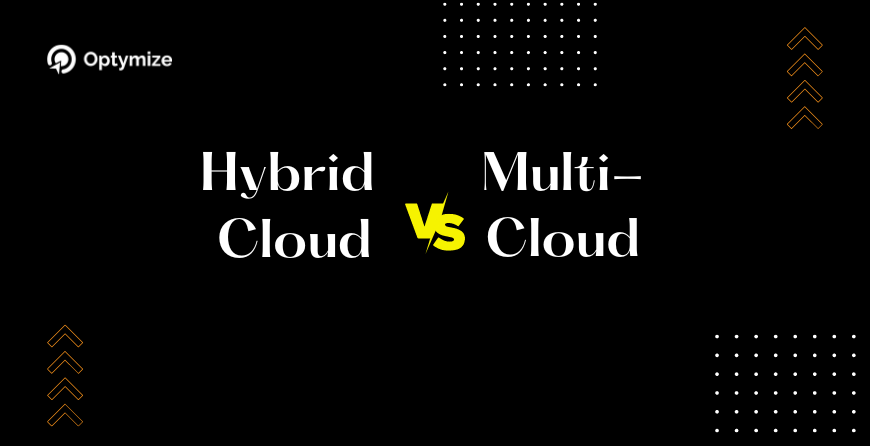In 2023, the debate between hybrid cloud vs multi-cloud is raising constantly. Cloud computing for business is not a need anymore but a necessity. To survive in this competitive tech market, businesses continue to explore the different types of cloud computing. Before that, it’s important to understand the difference between Hybrid and multi-cloud approaches.
Hybrid cloud and Multi-cloud are two cloud computing approaches that involve integrating more than one cloud. While both types involve the use of multiple clouds, there are some key differences.
A hybrid cloud infrastructure combines private and public clouds to create a unified system. This allows businesses to take advantage of public and private clouds while maintaining control over their sensitive data. The multi-cloud involves using multiple clouds of the same type from different vendors. This approach is used to avoid vendor lock-in and to leverage the specific strengths of different cloud providers.
This blog will explain the top 5 differences between hybrid cloud vs multi-cloud and their benefits. Whether you’re considering a hybrid could or multi-cloud, understanding the differences between them can help you make the best business decisions.
Hybrid Cloud vs Multi-cloud: What Are They?
What is Hybrid Cloud?
A hybrid cloud combines public cloud services, private cloud services, and on-premises infrastructure. It allows organizations to run their traditional or cloud-native workloads on the most suitable computing model, leveraging the benefits of both public and private clouds.
By using a hybrid cloud, companies can take advantage of the scalability and cost-effectiveness of public cloud services and also maintain control over data and applications with private cloud and on-premises infrastructure. A hybrid cloud provides flexibility and agility to move workloads freely between public and private clouds optimizing the use of resources and reducing costs.
A hybrid cloud allows companies to choose the best-of-breed cloud services and functionality from multiple cloud computing vendors. This enables organizations to avoid vendor lock-in and choose the most appropriate cloud environment for each workload. As a result, it improves performance and reduces costs.
What is Multi-Cloud?
Multicloud means the use of multiple cloud computing services from two or more public cloud providers. It helps organizations to leverage the unique offerings and strengths of different cloud providers reducing the risk of vendor lock-in. It increases flexibility and improves the resilience and reliability of the cloud environment.
Multicloud can refer to specific architectures where an application uses a service model, such as infrastructure-as-a-service (IaaS), platform-as-a-service (PaaS), or software-as-a-service (SaaS), across multiple cloud providers including on-premises data centres and colocation facilities. This approach is referred to as hybrid multi-cloud architecture.
3 Similarities Between Hybrid Cloud & Multi-Cloud
Hybrid Cloud & Multi-Cloud Can Store Sensitive Data
Sensitive data storage is determined by the infrastructure design and business requirements. Both hybrid and multi-cloud environments use a combination of on-premises, private, and public cloud infrastructures to store critical and sensitive data.
Hybrid Cloud & Multi-Cloud Has Tight Infrastructural Security
In both cases, cloud service providers are responsible for safeguarding the infrastructure from external threats and attacks. But the security of both hybrid and multi-cloud approachers heavily relies on the system’s architecture.
Hybrid Cloud & Multi-Cloud Manages regulation-specific data
Companies using the multi-cloud or hybrid cloud without a private cloud need to ensure that public cloud storage complies with standard regulations like HIPAA or GDPR. Public cloud providers have better cybersecurity resources. If your company is dealing with sensitive data, then you should choose a reliable provider with legal data storage options. This ensures the safe storage of regulatory data in a secure and isolated environment.
Top 5 Differences Between Hybrid Cloud vs Multi-cloud
Infrastructure combination:
The difference between hybrid cloud and multi-cloud is that a hybrid cloud combines different cloud types, such as private, public, and on-premises clouds, into a single, unified computing environment. But a multi-cloud uses services from multiple cloud providers without necessarily integrating them into a single environment.
Data storage:
Another difference between hybrid and multi-cloud data storage is that hybrid cloud offers the option to store data in various cloud types. But multi-cloud primarily relies on public cloud storage.
Application management:
A hybrid cloud provides a centralized management and orchestration platform that allows companies to monitor and manage applications across different cloud types. Multi-cloud lacks this centralized management feature.
Flexibility:
A hybrid cloud offers greater flexibility by allowing companies to move workloads between different cloud types. But multi-cloud is often more limited in terms of flexibility.
Complexity:
A hybrid cloud is generally more complex and may require more IT resources to manage and maintain than a multi-cloud, which can be more straightforward to deploy and use.
When Should a Company Use a Hybrid cloud?
A company should use a hybrid cloud when they have a need to:
- Keep some of their data and applications on-premises due to regulatory or compliance requirements, while leveraging the benefits of cloud services.
- Scale their IT infrastructure to handle fluctuations in demand and workload.
- Maintain control and security over sensitive data, while still being able to take advantage of the flexibility and scalability of cloud resources.
- Avoid vendor lock-in by using multiple cloud providers and avoiding reliance on a single vendor.
- Leverage the strengths and benefits of different cloud providers for different workloads or applications.
- Minimize latency and improve performance by keeping certain applications or data closer to the end-user or device.
When Should a Company use Multi-cloud?
A company should use a multi-cloud strategy when they have a need to:
- Avoid vendor lock-in and have the ability to switch between cloud providers to leverage the best services and pricing options available.
- Leverage different cloud providers’ strengths and benefits for different workloads or applications, such as using one provider for storage and another for processing.
- Improve resilience and reduce the risk of downtime by spreading workloads across multiple cloud providers, reducing the impact of any one provider’s outage or failure.
- Ensure compliance with regulations by using cloud providers that have the appropriate certifications and meet specific data sovereignty requirements.
- Optimize costs by using different cloud providers for different stages of the application lifecycle or based on the location of the user.
- Increase flexibility and agility by being able to rapidly provision and decommission cloud resources across multiple providers as business needs change.
- Support a global user base by leveraging cloud providers with data centers in different regions to improve latency and response times.
- Provide redundancy and disaster recovery solutions, where critical data and applications can be replicated and stored across multiple cloud providers and on-premises infrastructure.
A hybrid cloud platform offers the following benefits:
Increased Developer Productivity:
Adopting a unified hybrid cloud platform can enhance Agile and DevOps methodologies, enabling development teams to create and deploy applications across multiple clouds seamlessly. Developers can focus on developing once and deploying on all clouds, thus increasing their productivity.
Improved Infrastructure Efficiency:
With a unified hybrid cloud platform, organizations can achieve more granular control over their resources. This enables the development and IT operations teams to optimize resource allocation and costs across public and private clouds, and multiple cloud vendors. Additionally, businesses can modernize their applications faster and connect cloud services to data on-premises or on the cloud to deliver new value.
Enhanced Regulatory Compliance and Security:
A unified hybrid cloud platform lets businesses leverage best-of-breed cloud security and regulatory compliance technologies. It allows organizations to implement security and compliance standards across all their environments consistently.
Accelerated Business Growth:
A unified hybrid cloud platform enables businesses to shorten product development cycles, foster innovation, reduce time-to-market, and respond faster to customer feedback. It also helps to deliver applications closer to the client, for example, edge ecommerce, and integrate with partners or third parties to provide new products and services more quickly. The overall effect is accelerated business growth.
The following are the benefits of adopting a multi-cloud strategy:
Access to Innovation:
With a multicloud approach, organizations can leverage the strengths of different cloud providers and their specialized services. For instance, they can use platform-as-a-service (PaaS) offerings from providers that specialize in machine learning and artificial intelligence, or use providers that offer better services in certain geographic areas.
Increased Resilience and Reliability:
Organizations can achieve increased operational resilience by using multiple cloud providers for various services. This approach can help to spread the risk of potential service outages or data loss across multiple providers.
Reduced Risk:
By not relying solely on one cloud provider, organizations can reduce the risks associated with vendor lock-in and avoid the consequences of a single cloud provider’s issues.
Lower Costs:
Multicloud deployments enable organizations to select the most cost-effective cloud services for their needs, helping them to avoid vendor lock-in. Moreover, this approach can potentially provide more leverage to negotiate pricing with multiple providers.
Multi-cloud and Hybrid Cloud examples
Multi-cloud:
- A company using Amazon Web Services (AWS) for hosting their web applications, Google Cloud Platform (GCP) for big data analysis and machine learning, and Microsoft Azure for their DevOps toolchain.
- An e-commerce company using one cloud provider for their website, another cloud provider for payment gateway, and a third one for logistics and delivery management.
Hybrid cloud:
- An organization using a private cloud for running mission-critical applications with sensitive data, while utilizing a public cloud for non-critical applications or for additional computing resources during peak periods.
- A healthcare provider uses a hybrid cloud to securely store and process sensitive patient data on-premises while utilizing a public cloud for general applications and data analysis.
- An organization use a hybrid cloud to connect their legacy systems to a cloud-based application for better data management and automation.
Hybrid cloud vs Multi-cloud: FAQ
Q: What is a hybrid cloud?
A: A hybrid cloud combines a public cloud and a private cloud, where data and applications are seamlessly shared between the two. A hybrid cloud is designed to provide the benefits of both public and private clouds, including increased flexibility, scalability, and security.
Q: What is a multi-cloud?
A: A multi-cloud environment involves the use of multiple cloud services, such as Amazon Web Services, Microsoft Azure, and Google Cloud Platform, among others. In a multi-cloud setup, an organization can leverage the strengths of each cloud service to achieve specific goals, such as cost savings or increased flexibility.
Q: What is the difference between hybrid cloud and multi-cloud?
A: The key difference between hybrid cloud vs multi-cloud is in their architecture. A hybrid cloud combines a public and private cloud, while a multi-cloud use multiple cloud services. In a hybrid cloud, the public and private clouds work together to create a single, unified environment, while in a multi-cloud, the different cloud services are separate and distinct. Another key difference is in their intended use: a hybrid cloud is often used for workloads that require both security and scalability, while a multi-cloud is often used for cost optimization and to avoid vendor lock-in.







